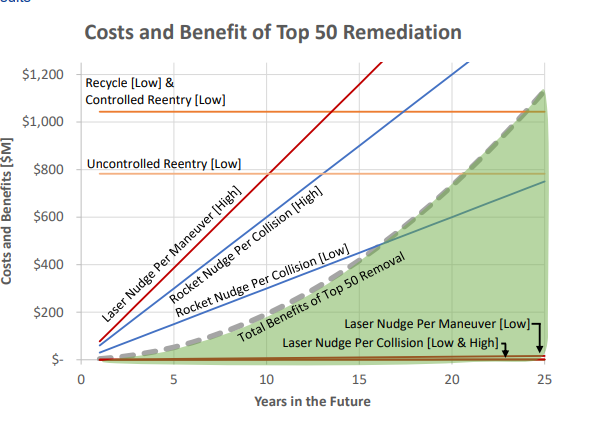NASA has released a new publication address the growing issue of space debris. Entitled ‘Cost and Benefit Analysis of Orbital Debris Remediation’, the report presents a cost-benefit analysis of various approaches to debris remediation, which refers to any action taken to reduce the risks posed by orbital debris by moving, removing, or reusing it. Understanding of the near-term costs and benefits of different remediation approaches is important to inform decision-making regarding R&D investment and policy creation in this field.
Main Findings
Finding 1: The most effective remediation methods to reduce risks to operators are approaches for removing small debris and nudging large debris to avoid collisions. Contrary to common concerns about the cost-prohibitive nature of remediation due to large upfront expenditures of deployment and long delays for receiving benefits, some remediation approaches may achieve net benefits in under a decade.
Finding 2: Controlled and uncontrolled reentry via reusable remediation servicer may reach net benefits on timescales that are relevant to spacecraft operators. Controlled reentry may be required for some large debris, particularly those in the Top 50, to avoid creating casualties or property damage on the ground. Contrary to the popular assumption that removal of such debris will not produce near-term benefits, NASA identified an approach to performing controlled reentry with a reusable spacecraft that might provide net benefits within three decades. This method of controlled reentry can also be adapted to provide uncontrolled reentries that are potentially cheaper than methods that use drag sails or tethers to de-orbit debris. In this case, performing an uncontrolled reentry is not much more expensive than a controlled reentry. However, NASA regard this finding with caution.
Finding 3: Recycling space debris has some attractive features but does not offer a clear risk advantage over other approaches. Converting a piece of debris into aluminum propellant, for de-orbiting the remainder of the object and for sale to other in-space customers, might be the most promising approach for recycling. However, it does not yield a substantially cheaper system than remediation systems that use chemical or conventional electric propulsion. On the one hand, turning debris into propellant saves costs by removing the need for in-space refueling assets and launches of propellant. NASA low-cost estimate for recycling also includes revenue from selling debris-sourced propellant to other in-space customers. However, these savings and revenue are offset by R&D costs needed to mature the capabilities to process debris into raw materials for subsequent use as propellant.
For more information visit:
www.nasa.gov




